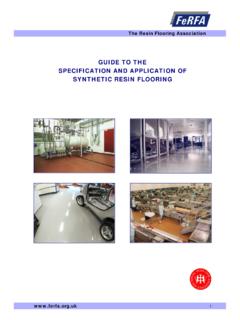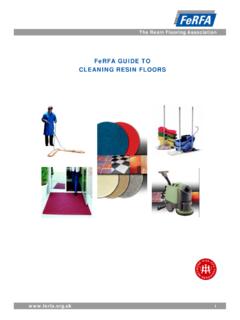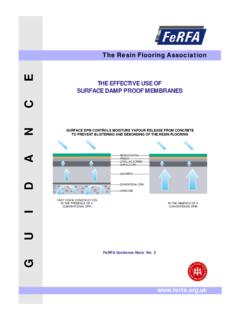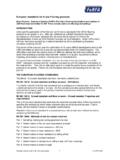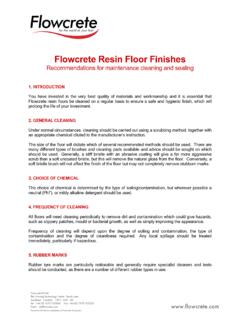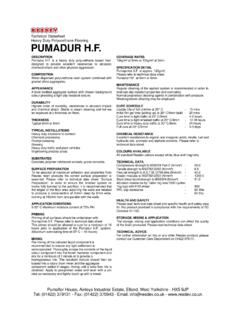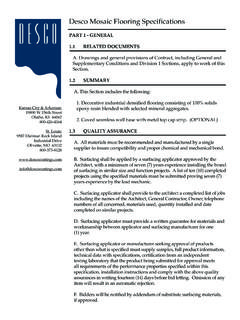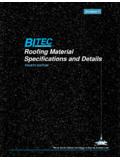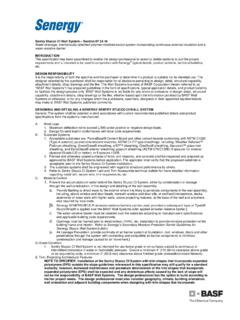Transcription of ANTI-STATIC FLOORING - NIFL Resin Flooring
1 Resin FLOORING AssociationANTI- static FLOORINGFeRFA Guidance Note: No. NEED FOR ANTI-STATIC FLOORINGWe will all be familiar with the effects of the build up of static electricity. Taking off a sweater made fromsynthetic fibre will often be accompanied with crackling sounds as sparks jump across. On some days wecan experience unpleasant shocks from touching car door handles particularly when wearing shoes withsynthetic soles. The same effects are responsible for the adhesion of dust on still surfaces. Under normalconditions these effects are, at the most, merely unpleasant but not particularly dangerous. However in theindustrial environment such electrostatic build-up can cause sparks of sufficient intensity to ignite vapours offlammable gas, cause dust explosions, or disrupt sensitive electronic floors are normally sufficiently conductive due to their pore water to dissipate any electrostaticcharges on the surface. However Resin FLOORING , often used to provide a more hard wearing or chemicallyresistant surface, is an effective natural insulator and could lead to substantial problems in somecircumstances.
2 In such cases an ANTI-STATIC grade of Resin FLOORING should be selected: in the most severecases a FLOORING that is fully conductive will be necessary. ANTI-STATIC grades are generally derived from normalResin FLOORING grades by incorporating a small proportion of carbon powder or fibres, but other moresophisticated solutions may be used by the APPLICATIONS FOR ANTI-STATIC FLOORINGAny industry where dust can present a problem or where stray electric currents are undesirable will haverequirements for ANTI-STATIC examples are: Electronic assembly, computers, TV tubes, Magnetic tape production, Semi-conductorproduction of integrated circuits, Micromechanics, Gyroscopes, Miniature bearings, CD or DVD players, Opticallenses, Photographic film, Lasers, Biotechnology, Antibiotic production, Genetic engineering, Pharmaceuticalmanufacture, Sterile disposables, Medical devices, Heart valves, Cardiac by-pass systems, Food & drinkproduction, Hospitals, Immunodeficiency therapy, Operating theatres, Clean rooms OF ELECTROSTATIC BUILD-UPAll contact between objects, separation of one item from another and each sliding of one thing on anothercauses a disturbance of electrical charge.
3 When this takes place faster than charge redistribution, staticcharge accumulates. The discharge of this electrostatic charge can lead to damage of sensitive devices suchas integrated circuits and the resultant spark as bodies at different electrostatic potential approach oneanother can ignite materials such as solvents and dust clouds leading to fire or obvious consequences of static charge build up on floors are cleaning problems arising where materialsadhere to the floor surface, for example, tea leaves. Sick building syndrome has been attributed to staticelectricity build up in the human body leading to stress and people have created problems by having old concrete floors re-furbished with normal Resin FLOORING , notrealising that this diminishes the excellent but unpredictable ANTI-STATIC properties of ground floor OF FLOORING MATERIALAnti- static grades of Resin FLOORING are available in Types 3 to 8 (coatings, self-smoothing and trowel appliedscreeds).
4 It is important for the specifier to understand that there is a wide range of products and propertiesavailable and to select the system that best meets the requirements for the working environment as a wholeand to not treat the individual elements in isolation. Colour should be discussed with the flooringmanufacturer, as there may be certain colour limitations on ANTI-STATIC FLOORING due to the darkening effect such as conductive and dissipative should be avoided as they mean different things to different exact range of acceptable resistance, test method (including test voltage) and any specific charge decayrequirements should be specified by the end user before selection of Resin FLOORING . Where a resistance quoted (in Ohms) it should be specified whether this refers to surface resistance (the resistance measuredbetween two electrodes placed on the surface of a material after a given time of electrification) or resistanceto ground (the resistance measured between a single electrode placed on the surface of a material and agroundable point).
5 In this case it should be specified whether ground refers to the protective earth of thepower distribution system (resistance to earth) or, for example, the steel frame of a building used as a returnpath for electric currents and as an arbitrary zero reference point. The test voltage must be specified as themeasured resistance will depend upon the applied industries have varying requirements and standards vary from country to country. Many industries ororganisations have their own internal standards for ANTI-STATIC FLOORING . Requirements may relate to the ANTI-STATIC or conductive nature of the FLOORING material to be used or to the ANTI-STATIC characteristics of thefinished the UK the standard frequently specified has been BS 2050, but this merely determined the electricalresistance across the surface (between 25 mm square electrodes placed 50 mm apart)and did not considereither the resistance through the thickness of the FLOORING onto the concrete base, or the resistance from thesurface to ground, both of which are important standards have since come into force that are more comprehensive in their approach.
6 The standardnow specified for FLOORING materials is EN 1081. This uses a tripod electrode with conductive rubber feet andprovides procedures for determining surface resistance, through resistance and resistance to it does not give any guidance as to what levels of conductivity are appropriate in different industrialsituations. This is where the designer needs to refer to industry-based the protection of Electrostatic Sensitive Devices BS IEC 61340-5-1 (superseding BS EN 100 015-1) BasicSpecifications: Protection is the current standard for the electronics industry in 22 European countries. Thisgives general requirements for surface resistivity, volume resistivity, resistance to ground and charge decayfor FLOORING . However, requirements may be different for the munitions industry, explosive handling areas,hospitals, solvent stores is currently no single British Standard that is universally applicable to all industries and all requirementsfor ANTI-STATIC FLOORING .
7 Therefore, the electrical properties, test method and test agency (contractor, client orthird party) should be agreed with the end user and discussed with the product manufacturer at the tenderingstage. The Health & Safety Executive may be able to offer advice on specific issues (08701 545500).APPLICATION OF ANTI-STATIC FLOORINGG eneralIf the programme allows, it is often helpful to lay a trial area of the ANTI-STATIC FLOORING , preferably 4 to 10 m2, atthe beginning of the contract. This will enable parties involved to agree on the appearance and testing of thefloor before the work progresses too PreparationIt is recommended that abrasive blasting be undertaken to prepare the surface. Cutting of rebates andstructural repairs such as making good of cracks, day joints and other defects should be undertaken prior toapplication of the primer. Where additional earthing is required, care should be taken to ensure that allsections of the floor are linked together expansion joints bridged with copper tape to provide electricalconductivity and that an earthing point is installed or available in a suitable location.
8 The application of asurface damp proof membrane will render any floor insulative whether on ground floor concrete or not andadditional earthing methods should then be an ANTI-STATIC floor is laid directly onto ground floor concrete there is usually enough electricaldissipation to ground so that no additional earthing is required. However, if an ANTI-STATIC floor is laid on aninsulating sub-floor, whilst it would create an ANTI-STATIC floor surface of equal potential, it is far better toinclude copper earth strips which are subsequently connected to the building s earth point to provide an floor not at equal potential but at ground potential. These strips, most commonly self-adhesive copperfoil tapes, are typically applied in a grid pattern of 4 to 8 metres a side or in a herringbone pattern beforeapplication of the ANTI-STATIC primer. In some cases, application around edges or columns only may berequired. The electrical continuity of the copper tape network should be verified before application of theprimer.
9 Copper tape is also used to bridge gaps such as expansion joints, beam joints, repairs or where anyfeature breaks up the continuity of the some cases an unmodified non-conducting primer is laid first in order to maximise adhesion to the concretesurface. Such a primer will act as an insulating layer and additional steps as outlined above will be needed toensure adequate is essential that sufficient earthing points are provided and these should be agreed with the buildingowner s addition to the usual purpose of improving the bond between sub-floor and Resin FLOORING , in some ANTI-STATIC systems the primer forms the main conductive layer and is critical to the electrical performance of thefloor. As such, the resistance of the primer layer should be verified prior to application of subsequent application of ANTI-STATIC FLOORING (including earthing and priming) is a specialised process. It is essentialthat the materials are mixed and applied according to the manufacturer s instructions to the correct thicknessonto suitable surfaces and properly tested for continuity and resistance at the various should always be carried out in conjunction with a qualified electrician to assess the quality of theconnection to some cases, the film thickness can affect the electrical properties therefore it is important to make suitableallowances for the profile (roughness) of the floor to ensure sufficient material is applied.
10 The applicationshould be made in a continuous process to ensure that continuity is achieved in each area and that electricalbridges are installed between areas. The applicator should provide evidence of the system meeting thespecified requirements on InstallationRoutine cleaning and wear may alter the electrical properties of FLOORING . Therefore, routine test methods andfrequency of tests should be agreed before completion, as should the agency responsible for these tests. Themanufacturer should be contacted for their recommendations regarding cleaning methods, materials,polishes etc. In particular selection of polishes should be done with care as some may act as and maintenance of the floor should be carried out in such a way as to preserve the electricalproperties. If parts of the floor become worn it needs to be borne in mind that a simple overcoating orpatching with a conductive system may not be effective because of the need to ensure electrical continuitybetween the new and old , the Resin FLOORING Association represents Resin FLOORING product manufacturers, specialist contractors and alliedtrades.
